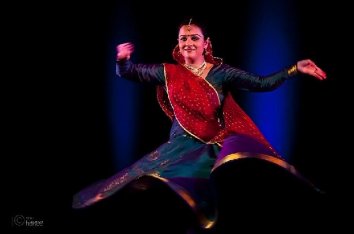
|   |

|   |
Nartan: An evening of Kathak Pics & text: Hareesh N Nampoothiri e-mail: newn.haree@gmail.com August 5, 2013 The dance form Kathak that originated in the Indo-Gangetic plains, presently enjoys the repute of being one among the most popular classical dance forms in northern India. When it comes to the southern part, Kathak performances are somewhat rare to find. Rasikas of Thiruvananthapuram were gifted with one such performance on the occasion of this year's Guru Purnima, when Monisa Nayak and her team presented Nartan - an evening of Kathak at Vyloppilli Samskriti Bhavan organized by Khanak Institute of Performing Arts, New Delhi. Monisa, an accomplished Kathak performer and a disciple of Rajendra Kumar Gangani, is also a winner of the prestigious Ustad Bismillah Khan Yuva Puraskar of Sangeet Natak Akademi. Four of her students; Malavika Sharma, Shruti Tanwar, Pratibha Sharma and Annu Gupta also joined her for the group recital. Monisa belongs to the Jaipur Gharana known for its layakari or rhythmic virtuosity and it was very much evident in all the choreographies presented here. There were a few items focusing on the nrithya part, but the entire performance focused largely on the nritha aspect, particularly on swift footwork and the signature chakkars (spins) of Kathak. Though the dancers did full justice and tried their best to make the absence of live orchestra look less prominent, it would have been better if they had added at least a tabla artist and tried those bols live instead of recorded bols and pre-choreographed footwork. 

Monisa Nayak led the show with her solo items and being a part of a few of the group performances. In solo, at first she presented a composition set in raag Kalavati portraying the romance and longing of a nayika for her beloved. Another recital was the enactment of a dialogue between the dancer and Lord Krishna set in Ada Chautal and raag Yaman. The group choreographies presented included Sri Vishnu Sthothra praising Lord Vishnu, Ananda Thandava of Lord Shiva, Tarana depicting love of Radha-Krishna, a traditional bhajan, a piece in which the dancers welcome the first rain of monsoon season and the concluding item Tarana set in Bhairavi. These presentations were also captivating as the dancers formed doubles, triples, quadruples and created some interesting formations out of it. Monisa Nayak, who conceptualized and choreographed the items, excelled in each and every item she had been a part of. Among the other members, Malavika Sharma was the one who looked promising. Nartan, as conceptualized by Monisa here, was not a traditional kind of Kathak performance. She trimmed and tamed the items and eight of them were presented at a stretch in the near 90 minute performance. Solo and group items were presented alternatively where the dancers changed their attire in between. It was like they were tracing the journey of Kathak from temples to the court of Mughals to the present stage as they moved from lehenga-choli to different varieties of chudidaar-kameez. It added more visual appeal and kept the interest level of the audience on the higher side. Instruments other than the traditional ones were also included in the background score. Lights were put to good use which helped to create the mood. These aspects complemented the performance very well and helped the dancers to create that wow effect among the viewers. At the same time, the true gist of Kathak was reflected in the choreographies, may be in a capsule form, which essentially was a fair trade-off between the traditional way of presentation and the taste of the present day viewers. Hareesh N Nampoothiri is a visual design consultant by profession and a lover of classical art forms. Being an ardent follower of Kathakali, he conceptualized and directed a documentary on Kathakali titled 'Thouryathrikam,' which introduces the nuances of Kathakali to the common man. Writing and photography are his other passions. |